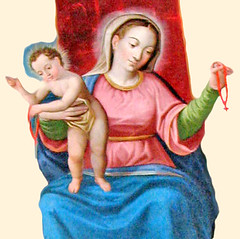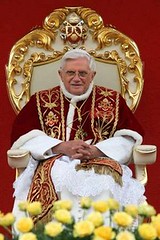Destined for the Rise and Fall of Many...
 The Feast of Candlemas is one of the most ancient feasts of Our Lady and is believed to derive its origin from the Liturgy of Jerusalem. Although in the Eastern Church the primary focus of this feast was the 'Hypapante', the meeting of Simeon with the Infant Jesus, in the Western Church it also marks the Purification of the Blessed Virgin Mary forty days after His birth, in accordance with the Mosaic Law. In both respects this Feast is connected with the mysteries of Christmas and the Epiphany and it is filled with Christmas joy, celebrating the revelation of Christ as the Light of the world. Hence it is a feast of light and the lit candles as well as the many texts of the Proper of the Mass serve to illuminate this. In particular, in the 1962 Roman Rite, five prayers were said in blessing the candles, although only one of these is retained in the reformed Roman Rite of 1970. The third of those is particularly fulsome in its reference to light and alludes beautifully to Simeon's canticle. It serves to highlight the key theme of today's Liturgy:
The Feast of Candlemas is one of the most ancient feasts of Our Lady and is believed to derive its origin from the Liturgy of Jerusalem. Although in the Eastern Church the primary focus of this feast was the 'Hypapante', the meeting of Simeon with the Infant Jesus, in the Western Church it also marks the Purification of the Blessed Virgin Mary forty days after His birth, in accordance with the Mosaic Law. In both respects this Feast is connected with the mysteries of Christmas and the Epiphany and it is filled with Christmas joy, celebrating the revelation of Christ as the Light of the world. Hence it is a feast of light and the lit candles as well as the many texts of the Proper of the Mass serve to illuminate this. In particular, in the 1962 Roman Rite, five prayers were said in blessing the candles, although only one of these is retained in the reformed Roman Rite of 1970. The third of those is particularly fulsome in its reference to light and alludes beautifully to Simeon's canticle. It serves to highlight the key theme of today's Liturgy:"O Lord Jesus Christ, the true Light, who enlightens all people who come into this world: pour forth your blessing upon these candles, and sanctify them with the Light of your grace; and mercifully grant, that as these lights enkindled with visible fire dispel the dark of night, so our hearts being illumined by invisible fire, that is, the bright splendour of the Holy Spirit, may be free from the blindness of every vice; that the eye of our mind being purified, we may perceive those things which are pleasing to you and useful to our salvation; so that after the dark perils of this world, we may deserve to arrive at the never-failing Light: through you, Christ Jesus, Saviour of the world, who in perfect Trinity lives and reigns, God, for ever and ever." Amen!
And yet, all is not light and joy in this Feast; for Simeon prophesies to Our Lady that "This child is destined for the falling and the rising of many in Israel, and to be a sign that will be opposed... and a sword will pierce your own soul too." Below, Hans Urs von Balthasar, writing in 'You Have the Words of Eternal Life', his ultimate opus, explains the tension and promise present in St Luke's account of the hypapante:
"The events are presented in an obviously stylized manner. The account begins with a threefold mention of the 'law', whether as the 'law of Moses' or the 'law of the Lord' (Lk 2:22-24), and it concludes with yet another mention of the 'law of the Lord' (2:39). The point of departure is the law's requirement that the new mother be 'purified' on the fortieth day after the birth of a boy, because she is 'unclean' as far as worship is concerned. Thus 'every male that opens the mother's womb' (Ex 22:28-29) must be presented as an offering to God and thereby 'redeemed'. The Gospel writer redirects attention from this motive to the presentation of the child Samuel, whose mother dedicated him to God for his entire life. Finally he mentions specifically the purification offering of the poor (according to Lev 12:8): 'A pair of turtle-doves or two young pigeons'. And so 'all has been done according to the law' - 'the custom of the law' (fifth mention of the law, Lk 2:27) is fulfilled.
Such a focus on obedience is confronted by an equally strong emphasis on the spirit. The Holy Spirit is mentioned three times in connection with the actions of the venerable Simeon. The Spirit 'is upon him' and present to him, revealing to him that he will see the Messiah before he dies; ultimately 'inspired by the Spirit', he 'comes to the Temple' at precisely the moment when the parents carry the child in. His entire song of thanksgiving directed to God with the child in his arms, no less than the prophecy that follows, is obviously delivered in the Spirit, just as were the words of the prophetess Anna, although the latter are not reported to us.
The astonishing thing about this story is that the minutely described obedience of the New Covenant is directed toward the Old Testament law, obscuring the distinction between old and new completely. It is as if the child, who like no other comes from God and belongs to God, must still be 'presented' and handed over to God; as if the one who conceived immaculately and gave birth virginally requires purification. No thicker veil could be drawn over the mystery of mother and child than this. On the other side of the line, the ancient people of God sparkle in the light of the Holy Spirit, who had promised in advance a vision of the new and brings about an encounter with the new at the first possible opportunity. The prophet and prophetess draw back the veil that obscured the mystery and reveal to the whole world the divine plan of salvation.
This is the 'light of revelation for the Gentiles', 'salvation in the presence of all nations', but it shines from the 'redemption of Jerusalem' (2:38) and is thus 'a glory to your people Israel' (2:32). 'Salvation comes from the Jews' (Jn 4:22), but 'the hour comes in which you will no longer worship the Father on this mountain and in Jerusalem' (Jn 4:21). How this expansion of something Jewish into something universal will take place the prophet tells directly to the Messiah's Mother, who in that role is the inclusive representative of Israel. The one who obeyed the law of Moses and through it obeyed God, even to the point of denying herself, is the one to experience the universalization of the Jewish law.
Her child is 'established for the fall and the rising of many in Israel', but not for both to the same degree. The 'sign that is contradicted' will be the significant one, the dominant one. 'His own received him not' takes the spotlight (Jn 1:11); he comes to being not peace but a sword, 'so that the thoughts of many hearts may be brought up into the light', and the 'whitewashed tombs' might be 'opened' (Mt 23:27; 27:52), so that the promised 'light of revelation' might penetrate to the ultimate depths until 'everything lies bare and uncovered before the eyes of him before whom we must give account' (Heb 4:13). The child of praise is 'the true light that enlightens every man' (Jn 1:19), a light that is both salvation and judgment at the same time, depending on whether the enlightened one opens himself up to the light or shrinks from it (Jn 3:19-21).
Yet the sword that this child carries (simply by existing) will 'also pierce your heart' (Lk 2:35), a heart that is incapable of division, whose obedience is perfected beyond any concern for itself, yet a heart that, as the Mother of men (and especially of Israel) must share the pain of the judgment. As the Mother of the Son, she feels the sword that the Son must wield for the 'healing of the nations' slice through her heart."
The original illustration above of the the prophet Simeon holding the Child Jesus is by David Jones (1885-1974) and it was drawn in 1922, possibly in Ditchling, and it is part of the patrimony of the Priory.







1 Comments:
I voted you for "Best Devotional" Couldn't figure out quite what else. They really should have religous and priests as to separate categories..
Really, there should be a category JUST FOR DOMINICANS:-)
Happy Feast of Candlemas!
Post a Comment
<< Home